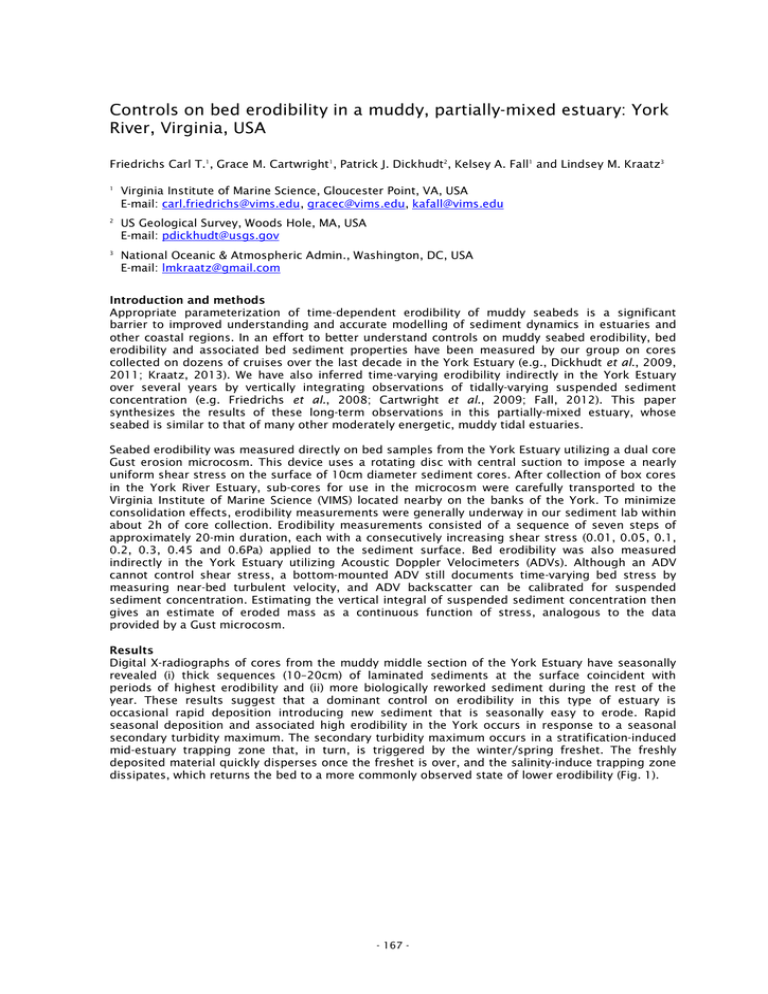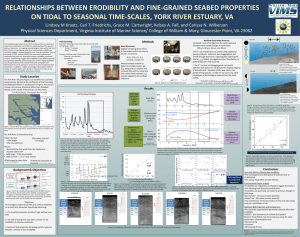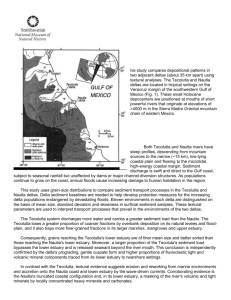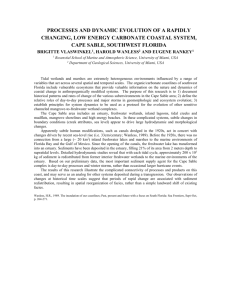Controls on bed erodibility in a muddy, partially-mixed estuary: York
advertisement

Controls on bed erodibility in a muddy, partially-mixed estuary: York River, Virginia, USA Friedrichs Carl T.1, Grace M. Cartwright1, Patrick J. Dickhudt2, Kelsey A. Fall1 and Lindsey M. Kraatz3 1 Virginia Institute of Marine Science, Gloucester Point, VA, USA E-mail: carl.friedrichs@vims.edu, gracec@vims.edu, kafall@vims.edu 2 US Geological Survey, Woods Hole, MA, USA E-mail: pdickhudt@usgs.gov 3 National Oceanic & Atmospheric Admin., Washington, DC, USA E-mail: lmkraatz@gmail.com Introduction and methods Appropriate parameterization of time-dependent erodibility of muddy seabeds is a significant barrier to improved understanding and accurate modelling of sediment dynamics in estuaries and other coastal regions. In an effort to better understand controls on muddy seabed erodibility, bed erodibility and associated bed sediment properties have been measured by our group on cores collected on dozens of cruises over the last decade in the York Estuary (e.g., Dickhudt et al., 2009, 2011; Kraatz, 2013). We have also inferred time-varying erodibility indirectly in the York Estuary over several years by vertically integrating observations of tidally-varying suspended sediment concentration (e.g. Friedrichs et al., 2008; Cartwright et al., 2009; Fall, 2012). This paper synthesizes the results of these long-term observations in this partially-mixed estuary, whose seabed is similar to that of many other moderately energetic, muddy tidal estuaries. Seabed erodibility was measured directly on bed samples from the York Estuary utilizing a dual core Gust erosion microcosm. This device uses a rotating disc with central suction to impose a nearly uniform shear stress on the surface of 10cm diameter sediment cores. After collection of box cores in the York River Estuary, sub-cores for use in the microcosm were carefully transported to the Virginia Institute of Marine Science (VIMS) located nearby on the banks of the York. To minimize consolidation effects, erodibility measurements were generally underway in our sediment lab within about 2h of core collection. Erodibility measurements consisted of a sequence of seven steps of approximately 20-min duration, each with a consecutively increasing shear stress (0.01, 0.05, 0.1, 0.2, 0.3, 0.45 and 0.6Pa) applied to the sediment surface. Bed erodibility was also measured indirectly in the York Estuary utilizing Acoustic Doppler Velocimeters (ADVs). Although an ADV cannot control shear stress, a bottom-mounted ADV still documents time-varying bed stress by measuring near-bed turbulent velocity, and ADV backscatter can be calibrated for suspended sediment concentration. Estimating the vertical integral of suspended sediment concentration then gives an estimate of eroded mass as a continuous function of stress, analogous to the data provided by a Gust microcosm. Results Digital X-radiographs of cores from the muddy middle section of the York Estuary have seasonally revealed (i) thick sequences (10–20cm) of laminated sediments at the surface coincident with periods of highest erodibility and (ii) more biologically reworked sediment during the rest of the year. These results suggest that a dominant control on erodibility in this type of estuary is occasional rapid deposition introducing new sediment that is seasonally easy to erode. Rapid seasonal deposition and associated high erodibility in the York occurs in response to a seasonal secondary turbidity maximum. The secondary turbidity maximum occurs in a stratification-induced mid-estuary trapping zone that, in turn, is triggered by the winter/spring freshet. The freshly deposited material quickly disperses once the freshet is over, and the salinity-induce trapping zone dissipates, which returns the bed to a more commonly observed state of lower erodibility (Fig. 1). - 167 - Fig. 1: Conceptual model for York Estuary dynamics (modified from Dickhudt et al., 2009). The more commonly observed ‘low’ erodibility state represents a more biologically influenced, pelletized bed with ongoing competition between the effects of physical resuspension and consolidation versus biological reworking and repackaging. For example, observations over several consecutive weeks starting about one month after the end of the winter/spring freshet have demonstrated a tendency for the erodibility of biologically reworked sediment to slowly decrease, consistent with both dewatering and a progressive winnowing of the most easily suspended material from the uppermost centimetre. As time passed, the percentage of resilient muddy pellets, median pellet size, content of fine sand, and median sand size were all observed to increase at the surface, while the percent water, organics, silt, and 7Be activity decreased. Consistent with recent advances in cohesive bed modelling, results suggest that cohesive-like consolidation and noncohesive-like bed armouring occur simultaneously in pelletized muddy beds. Along with a tendency for erodibility to increase following deposition events and decrease with dewatering and bed armouring, this study also identified a superimposed temporal oscillation in erodibility correlated to tidal range. A larger tidal range drives stronger tidal currents that then disturb the bed, partly counteracting the temporal effects of armouring/consolidation. It was found that the correlation between eroded mass and low-passed tidal range peaked when tidal range was averaged over 11 semi-diurnal tidal cycles immediately preceding core collection. This suggests a characteristic bed consolidation time scale of about 5 to 6 days under conditions of ongoing, moderate disturbance. Consolidation over a several-day time-scale, ‘reset’ by intermittent resuspension events, is also qualitatively consistent with recently developed models for timedependent cohesive seabed erodibility. References Cartwright G.M., C.T. Friedrichs, P.J. Dickhudt, T. Gass and F.H. Farmer. 2009. Using the acoustic Doppler velocimeter (ADV) in the MUDBED real-time observing system. p.1428-1436. In: OCEANS 2009, Institute of Electrical and Electronics Engineers, ISBN: 978-1-4244-4960-6. Dickhudt P.J., C.T. Friedrichs, L.C. Schaffner and L.P. Sanford. 2009. Spatial and temporal variation in cohesive sediment erodibility in the York River Estuary: a biologically-influenced equilibrium modified by seasonal deposition. Marine Geology 267:128-140. - 168 - Dickhudt P.J., C.T. Friedrichs and L.P. Sanford. 2011. Mud matrix solids fraction and bed erodibility in the York River and other muddy environments. Continental Shelf Research 31(10S):S3-S13. Fall K.A. 2012. Relationships among fine sediment settling and suspension, bed erodibility, and particle type in the York River Estuary Virginia. MS Thesis. College of William & Mary. 144p. Friedrichs C.T., G.M. Cartwright and P.J. Dickhudt. 2008. Quantifying benthic exchange of fine sediment via continuous, non-invasive measurements of settling velocity and bed erodibility. Oceanography 21(4):168-172. Kraatz L.M. 2013. Acoustic and sedimentological investigations of seabed conditions and related bio-physio-geological parameters in a tidally energetic, fine-grained environment: York River Estuary, Virginia. PhD Dissertation. College of William & Mary. 199p. - 169 -






